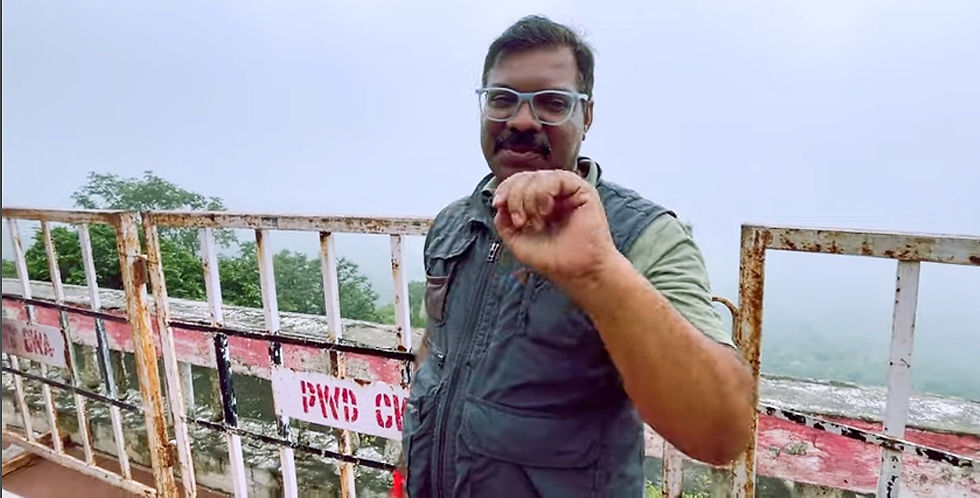A Journey into the Unknown: Exploring the Mystical Patalkot Valley & Tamia
- ashokkdas1958
- Feb 12
- 9 min read
Exploring the Mystical Patalkot Valley & Tamia
आंखों के समन्दर, पातालकोट के गलियां,
हर कोना है यहां, एक कहानी कि जुबानीयां ।
प्रकृति की गोद में, बसा है ये प्यारा जहां,
यहां के राज, आज बताएंगे सफरनामा ।।
The beautiful hill station Pachmarhi, also known as the Queen of Satpura Range, is one of the most visited hill station in Madhya Pradesh. While planning my itinerary to Pachmarhi, I stumbled upon one hidden gem, the Patalkot Valley, and was immediately captivated by its promise of tranquility and natural beauty. Intrigued by the prospect of a serene detour, I decided to explore this lesser-known mystic destination on my way to Pachmarhi. The two days I spent immersing myself in the serene landscapes of Patalkot and Tamia turned out to be a major highlight of my Pachmarhi tour, leaving me with cherished memories of untouched nature and heartwarming hospitality.
A Journey into the Unknown : The Enigmatic Valley of Patalkot
Hidden deep within the Satpura Range of Madhya Pradesh, lies the enigmatic Patalkot, a secluded valley often dubbed the "Hidden Valley." As the name suggests, Patalkot means an underground fortress. In Sanskrit language "Patal" refers to deep under the ground and "Kot" means Fortress or Palace. It is located in a horse shoe shaped valley which is below the surrounding ground level and sunray hardly reaches the base of this valley thus it was named Patalkot.
A horseshoe-shaped haven, Patalkot is surrounded by towering cliffs and dense forests. Its floor is dotted with quaint villages inhabited by the indigenous Gond and Bharia tribes. The pristine natural beauty, coupled with the unique cultural heritage of its inhabitants, makes Patalkot a truly captivating and timeless destination. This remote and picturesque region, accessible only by a challenging trek or smaller vehicles, offers a glimpse into a world untouched by time.
Legends associated with Patalkot
Patalkot! The name is steeped in mythological lore. Legends associated with the Ramayana link it to the entrance of the mythical Patal Lok. These tales, coupled with the valley's secluded nature, contribute to its enduring mystique. Some of the prominent legends include:
· Meghnad's Descent: The valiant Prince Meghnad, son of the formidable Ravana, is believed to have descended to Patal Lok, the home of the demons and nagas (serpents), through Patalkot after worshipping Lord Shiva.
· Mata Sita's Earthly Embrace: The ethereal Sita Mata, after her trials, is believed to have disappeared into the Earth at Patalkot, leaving behind a bowl-shaped cavity.
· Hanuman's Journey Underworld: The indomitable Hanuman, in his quest to rescue Rama and Lakshmana from the clutches of the demon Ahiravana, is said to have traversed to the Patal Lok through Patalkot.
· Bhasmasur's Misfortune: A legend associates Patalkot with Bhasmasur, a demon who, after attaining from Lord Shiva the boon of being able to reduce anyone to ashes just by placing his hand on their head, rushed to place his hand on the giver of the boon. Lord Shiva, realising his folly scooted heaven and jumped to earth on this very place causing this huge pit.
The Bharia Tribe of Patalkot Valley : Guardians of the Forest
Despite its legendary status, the Patalkot valley remained largely unknown to the outside world until recent times. Centuries ago, the Bharia tribe descended into this secluded valley, developing a unique culture, practices, and language—a Dravidian tongue known as Bharia. Their self-sufficiency allowed them to live in isolation, with minimal interaction with the outside world. In fact, some of the valley's settlements were only discovered a few years ago.
Of the 25 villages in Patalkot, only 12 are currently inhabited. The remaining 13 lie deserted. Nestled deep within the valley, some villages receive sunlight for less than six hours a day. In certain areas, sunlight reaches only for four months of the year. During this brief period, the tribal people descend to these regions to cultivate crops, harvest them, and then return to higher ground.
The Bharia tribe has a profound connection to the forest. They possess a wealth of knowledge about medicinal plants and traditional healing practices, passed down through generations. These tribal people rely solely on these natural remedies, eschewing modern medicine. We had the privilege of meeting Bhumkas, the tribe's herbal healers, who shared their knowledge of various herbs and roots and their medicinal properties.
The Bharia tribe exemplifies the 'farm-to-table' concept that modern society strives to emulate. Surrounded by dense forests teeming with diverse flora and fauna, they have learned to live in harmony with nature, demonstrating a sustainable and traditional way of life.
Exploring the Mystical Patalkot Valley
Step into the valley and discover a realm of endless exploration. Patalkot, a haven for adventure seekers, offers a plethora of heart-pounding activities. Trek through rugged trails, scale towering cliffs, pitch a tent under the starry sky, or rappel down sheer drops. The valley's diverse landscape, from lush green plateaus to deep, mysterious gorges, is a photographer's paradise. Witness the serene beauty of cascading waterfalls and the vibrant culture of traditional Bharia villages, all interwoven with the golden tapestry of cornfields. Here's a glimpse into some of its most alluring tourist attractions:
Nature's masterpiece: The Rated View Point
The Rated View Point, a vantage point at 1,200-1,500 feet, offers a breathtaking panorama of the Patalkot Valley. The valley’s lush, verdant landscape, punctuated by cascading waterfalls and deep gorges, is a sight to behold. During the monsoon season, the valley transforms into a vibrant tapestry of green, making the view even more mesmerizing. From this viewpoint, visitors can capture stunning photographs and admire the serene beauty of the surrounding landscape, including the quaint villages of Rated and Chimtipur nestled amidst the hills. Easily accessible by road, the Rated View Point is a must-visit for anyone exploring the natural wonders of Patalkot.
Chimtipur View Point: Lost in the mist of Patalkot
Atop the Patalkot Valley, Chimtipur View Point is another vantage point that offers a stunning panorama of the valley's natural beauty. The deep gorges and the lush greenery create a breathtaking sight, especially during the monsoon season when the valley is cloaked in mist. The gentle tinkling of cattle bells and the ever-changing cloudscape add to the serene ambiance. Chimtipur View Point is not just a visual treat but also a gateway to explore the rich cultural heritage of the Patalkot Valley. As you admire the view, you'll also be immersed in the region's cultural tapestry, making Chimtipur a truly unforgettable experience.
A Journey to Kaream: A Glimpse into Bharia Tribal Life
After a winding, hour-long descent of over 1,500 feet through lush forests and along narrow roads from Chimtipur View Point, we reached the end of the motorable road leading to Kaream Village. This secluded hamlet, nestled deep within the Patalkot Region, offers a rare glimpse into the lives of the Bharia tribe, one of India's lesser-known indigenous communities.
Accessible only by foot or small vehicles, Kaream remains largely untouched by the outside world, preserving its rich cultural heritage and pristine natural beauty. As the name suggests, the village is surrounded by black mango trees. Its traditional mud and thatch houses are a testament to the Bharia people's age-old customs and traditions.
Kaream's serene beauty and warm hospitality make it an unforgettable destination. Here, time seems to slow down as visitors immerse themselves in the tranquility of nature and the simplicity of village life. By visiting Kaream, you can contribute to the preservation of this unique cultural heritage and support the sustainable development of the village.
Tamia: A Hill Station's Serene Embrace
Amidst lush greenery, Tamia is the gateway to the mystical Patalkot Valley. At the same time, this picturesque hill station, conveniently located on the Chindwara-Pachmarhi route, offers breathtaking views, serene surroundings, and limited but comfortable accommodations. More than just the base camp for Patalkot tour or a relaxing stop on the way to Pachmarhi, Tamia also gives excellent opportunity to unwind amidst nature's beauty, trek through lush green trails, and simply soak in the tranquility and connect with nature.
Tamia boasts a variety of intriguing tourist destinations. The Tribal Museum provides a fascinating glimpse into the rich cultural heritage of the indigenous tribes, showcasing a stunning collection of artifacts, traditional attire, and handicrafts that offer insights into their unique way of life and customs. The Tamia Water Reservoir, a tranquil haven surrounded by rolling hills, offers opportunities for boating, fishing, or simply relaxing by the water's edge and soaking in the peaceful ambiance.
The pinnacle of scenic beauty, in my opinion, is the View Point at Rest House Tamia. Perched dramatically over a deep gorge, it offers breathtaking vistas of the surrounding landscape, especially at dawn and dusk. The sunrise and sunset, painting the hills and valleys in golden hues, are truly unforgettable. Even during the monsoons, the clouds rolling through the valley create a mesmerizing spectacle. The well-preserved British Colonial building, perched on the cliff's edge, adds to the overall charm of this idyllic location.
Patalkot ki Rasoi: A Culinary Journey into Tribal India
The story of Patalkot and Tamia is incomplete without mentioning about a unique initiative – Patalkot Ki Rasoi. Under able leadership of Sri Pawan Srivastava, Patalkot ki Rasoi is a unique initiative by Tribescapes that has emerged from this enchanting valley in recent years. This culinary venture aims to preserve and promote the indigenous food culture of the Gond and Bharia tribes, offering visitors a truly authentic and unforgettable dining experience at the tribal household.
A Taste of Tribal Delights
Patalkot ki Rasoi is more than just a restaurant; it's a cultural immersion. The menu features a delectable array of traditional tribal dishes prepared using locally sourced ingredients and age-old recipes. From hearty millet-based meals to exotic wild vegetable curries, each dish tells a story of the region's rich culinary heritage. Some of the must-try dishes at Patalkot ki Rasoi include: Millet Rotis, Kutki ki chawal, Wild Vegetable Curry, Khar Soup, Mave ki Puri and Mahua Puri with Rabidi, etc.
More Than Just Food : A Sustainable Initiative
Beyond the culinary delights, Patalkot ki Rasoi also offers a glimpse into the vibrant tribal culture of the region. You can witness traditional cooking techniques, interact with local artisans, and even participate in workshops on tribal food preparation. In addition to preserving culinary traditions, Patalkot ki Rasoi is also about promoting sustainable practices. The initiative supports local farmers and artisans, ensuring the economic well-being of the community. Additionally, by promoting the use of millets and traditional cooking methods, Patalkot ki Rasoi contributes to a healthier and more sustainable food system.
A Must-Trying travel experience for Food Lovers and Culture Enthusiasts
Whether you're a food lover, a culture enthusiast, or simply seeking an authentic travel experience, Patalkot ki Rasoi is a must-trying experience. Immerse yourself in the flavors and traditions of tribal India, and savor the unique and unforgettable experience that Patalkot has to offer.
Plan Your Visit :
Best Time to Visit: The best time to visit Tamia-Patalkot is during the monsoon season (July to September) when the landscape is lush green and waterfalls are at their peak and misty valleys create a picturesque landscape. However, the winter months (October to February) also offer pleasant weather, making it suitable for trekking and camping.
How to Reach: Tamia, the gateway to Patalkot valley, is conveniently located on the main road connecting Pachmarhi and Chindwara and has good road connectivity from major cities in Madhya Pradesh. The nearest airports are in Nagpur, Jabalpur, and Bhopal. Chindwara is the nearest railhead well-connected with major cities,
Where to Stay: While Tamia offers a few hotels and resorts for comfortable stays, the region's accommodation options are limited. If you're visiting during the winter months, you may check out for campsites that open up in the region during that period. The recent addition to the region's tourism scene is the concept of homestays, though not stabilized yet. Once stabilized, this will definitely provide truly authentic experience to immerse in the local culture and lifestyle
For a comfortable and convenient stay, I highly recommend Motel Tamia. This well-appointed property, once managed by the MP Tourism Department, is located on Tamia's main road and provides excellent dining and accommodation facility.
Tips for Your Visit:
Hire a Local Guide: A local guide can provide valuable insights into the region's history, culture, and ecology.
Respect the Environment: Avoid littering and disturbing the wildlife.
Support Local Communities: Purchase local handicrafts and souvenirs to support the indigenous tribes.
If you are planning to visit Tamia and Patalkot, I won’t hesitate to recommend to take the Patalkot Ki Rasoi experience with Sri Pawan Srivastava (Mobile: +91 6264030609, Email: tribescapes@gmail.com) and Tribescapes to experience the rich tribal heritage and unspoiled natural beauty of Patalkot and Tamia. If you are interested, they do also arrange for trekking, hiking and camping, etc..

Conclusion :
Walking through the unspoiled Bharia tribal villages nestled in the mystical Patalkot Valley was an unforgettable experience. This hidden treasure, located near the famous hill station of Pachmarhi, has long remained shrouded in obscurity. It's hard to imagine that people have lived and thrived in this deep gorge for generations. However, thanks to initiatives like Patalkot ki Rasoi and Madhya Pradesh Tourism's Dekho Apna Desh, Azadi Ka Amrit Mahotsav and Millet Mission campaigns, this enchanting natural beauty is gradually emerging from the shadows and attracting the attention of tourists.
For those seeking an authentic and off-the-beaten-path travel experience, Patalkot is an ideal destination. The challenging trek, the breathtaking scenery, and the unique cultural heritage make it a truly unforgettable adventure.
Do stay with me. After exploring the Mystical Patalkot Valley & Tamia and continuing my journey ahead, I will share my experiences of Pachmarhi, the Queen of Satpura, in my next post.
For a video presentation on Jiranga, please check YouTube post “Patalkot Chhindwara l Tamia l Patalkot ki Rasoi https://youtu.be/PMwiwXBQr24?si=s1OkhsoxP6Iqq2V5“ at PlacesDishes hosted by my co-traveler.
For similar posts on other interesting destinations,
please visit my site www.ghumnechalo.in











































































Comments